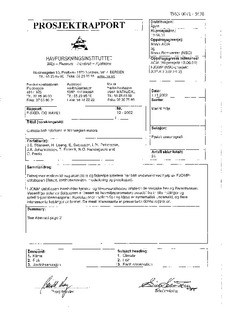Climate-fish relations in Norwegian waters
Stiansen, Jan Erik; Loeng, Harald; Svendsen, Einar; Pettersson, L.H.; Johannessen, Johnny A.; Furevik, Tore; Handegard, Nils Olav; Fredo, O.
Research report
Permanent lenke
http://hdl.handle.net/11250/113319Utgivelsesdato
2002Metadata
Vis full innførselSamlinger
- Fisken og havet (1958- ) [700]
Sammendrag
Climate variability and change in the Arctic and Sub-Arctic regions have become increasingly
important issues over the past few decades. The goal of the Arctic Climate Impact Assessment
(ACIA) is to evaluate and synthesize knowledge on climate variability, climate change, and
increased ultraviolet radiation and their consequences. Combined analysis of marine data
records based on field observations and satellite Earth observation data records are being
investigated in order to determine the relations between the variability in the marine physical
and biological environment. The increased availability of satellite Earth observation data
during the last 30 years have improved the role of use of these type of observations in the
assessment of longer term variation in marine ecosystems. This report is mainly based on
results from the FJOMP project (Fishery, Earth observation, Modeling and Prediction). The
goal of the FJOMP project is to elaborate the use of satellite based information about the
marine environment in the studies of the variability in the fish recmitment and stock
assessment.
The response of climate variation on the fish population is not well understood. In many
stocks knowledge of the relationship between larvae and recruits and between recmits and
spawning stock biomass is poor. Identifying which climate variables that have an impact on
the fish at its different life stages may improve the knowledge of these relationships.
Under the project FJOMP, a database, with the same name, with fishery and climate (mostly
satellite based) time series was established. At this stage more than 40 climate and more than
30 fishery time series are included in the database. This database serves as a platform for a
statistically approach in search for climate variables of importance for the fish populations.
The effect of climate variation on fish recmitment and stock status has been investigated. In
this study we have focused mainly on the relations between the ocean physical climatology
and the three species, North East Arctic cod, Norwegian spring spawning herring and Barents
Sea capelin. Climate and fishery time series in the FJOMP database have been systematically
correlated, also with time lag, in order to search for interesting relationships. Also, multiple
regression models have been used to further improve some of the most interesting correlations
found.
It is not the intent of this report to give deeper discussions on mechanisms and processes that
link the climate variability to the fish populations, but instead give a taste of what this kind of
linkage can give of contribution to the understanding of climatically effects on fishery
recruitment and fish population variation.
The results show that the North Atlantic Oscillation index (NAO) index and the sea surface
temperature (SST) in general are two important climate variables for fish recmitment
(however, they are not independent as NAO have a large impact on SST). Especially the NAO
index gives good relations to several recruitment parameters for North East Arctic cod, while
SST is more important for Barents Sea capelin and Norwegian spring spawning herring. In
addition sensible heat flux, ice cover and heat transport are other important climate variables,
which are related to the variability of the various fish classes and recruitment.
NORSK SAMMENDRAG:
Relasjoner mellom klimaparametere og fiskeriparametere har blitt undersøkt ved hjelp av FJOMPdatabasen
(fiskeri, jordobservasjon, modellering og prediksjon).
FJOMP-databasen inneholder fysiske- og fiskeriparametere relatert i de nordiske hav og Barentshavet.
Vesentlige deler av databasen er basert på havmiljøparametere avledet fra in-situ-målinger og
satellitt-jordobservasjoner. Korrelasjoner mellom fisk og klima er systematisk undersøkt, og flere I interessante koblinger er funnet. De mest interessante er presentert i denne rapporten.
Utgiver
HavforskningsinstituttetSerie
Fisken og havet2002-12
